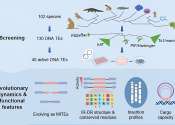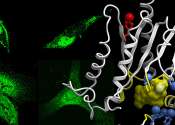Last update:
Molecular & Computational biology news

Elevating analysis of genomic data with advanced mathematical techniques
A novel approach to analyzing single-cell RNA sequencing (scRNA-seq) data has been unveiled by NUS researchers. This method promises to enhance both the precision and speed of data interpretation, potentially accelerating ...
Molecular & Computational biology
4 minutes ago
0
0

AI meets biophysics: New approach identifies critical interaction points in cancer-related proteins
Researchers at Auburn University, in collaboration with scientists from the University of Basel and ETH Zurich, have made an advance in the fight against cancer. The team, led by Dr. Rafael Bernardi, Associate Professor of ...
Molecular & Computational biology
17 hours ago
0
43

New mRNA and gene editing tools offer hope for dengue virus treatment
Dengue virus, a painful and sometimes fatal mosquito-borne infection well known in tropical countries, is surging rapidly across the planet. Now, 4 billion people live in places at risk for the disease, like the southeastern ...
Cell & Microbiology
17 hours ago
0
31

Plant scientists link phospholipid sensing with control of gene expression
Plant scientists have long known that phosphorus is a crucial component in plant growth. A major discovery by a Kansas State University (K-State) biologist and her lab is leading to a better understanding of how plants detect ...
Plants & Animals
17 hours ago
0
8

Q&A: How single-cell and spatial proteomics reveal proteins' nuanced roles in health and disease
When Steve Carr, senior director of the Proteomics Platform at the Broad Institute of MIT and Harvard, began working in proteomics, the field was able to detect only the most abundant proteins in a given sample. In recent ...
Molecular & Computational biology
17 hours ago
0
1

Decoding the language of cells with the power of proteomics
Hundreds of millions of years ago, single cells joined forces to become multicellular organisms. At the foundation of this multicellular world is the cell surface: the plasma membrane surrounding each cell, where individual ...
Cell & Microbiology
17 hours ago
0
37

Cohesion at the cellular level is flexible yet stable, study shows
The tissue in our body can only hold together if the cells adhere not only to each other, but also to extracellular structures, such as collagen fibers of the connective tissue and the skin. How exactly does this work on ...
Cell & Microbiology
18 hours ago
0
78

Angiosperms study provides insights into genome evolution after whole-genome duplications
Whole-genome duplication (WGD, or polyploidy) is a common and frequent occurrence in plants, providing raw genetic material for evolution. Homoeologs (duplicate genes from a WGD) often diverge in expression levels, while ...
Plants & Animals
20 hours ago
0
2

Researchers develop molecular biosensors that only light up upon binding to their targets
Biosensors—devices that use biological molecules to detect the presence of a target substance—have enormous potential for detecting disease biomarkers, molecules-in-action in diverse biological processes, or toxins and ...
Biotechnology
22 hours ago
0
59

Algorithm maps protein degradation patterns to improve infection diagnosis and treatment
Peptides are small fragments of proteins, mainly found in the skin and mucous membranes. Some peptides act as a barrier, protecting the body against infections by fighting off microorganisms like bacteria, viruses, and other ...
Cell & Microbiology
22 hours ago
0
52

Regulatory gene influences shape recognition in medaka fish, scientists discover
Medaka fish that lack functional Hmgn2 genes are unable to distinguish between simple shapes, revealing a new function for the regulatory gene.
Plants & Animals
Sep 5, 2024
0
1

Researcher helps develop new technique to explore oceanic microbes
When Southern Methodist University (SMU) researcher Alexander Chase was a young boy, the sheer diversity of plants in Earth's tropical rainforests fascinated him. He found himself wondering what new species were out there, ...
Cell & Microbiology
Sep 4, 2024
0
66

RNA editing plays critical role in fruit flies' sense of smell and social interactions
Imagine your DNA as a set of instructions or a recipe book that tells your body how to make everything it needs to function, from proteins to cells. Every time the body needs to build something, it reads these instructions. ...
Plants & Animals
Sep 4, 2024
0
10

Researchers find genetic variant for speed of hair graying, susceptibility to skin melanoma in horses
Graying with age is a common coat color variant in horses, characterized by progressive hair graying and susceptibility to skin melanoma. In a new study published in Nature Communications, an international consortium led ...
Molecular & Computational biology
Sep 4, 2024
0
11

Genomic analyses of prairie chickens cast doubt on species classifications
Biologists originally classified the lesser and greater prairie chickens of the Great Plains as two different species. Difficult to distinguish by their physical appearance alone, some scientists have wondered for decades ...
Ecology
Sep 4, 2024
0
27

Brazilian researchers discover key gene regulating virulence of fungus that causes severe lung infections
A group of Brazilian researchers has found a potential target for novel therapeutic strategies to combat fungal infections—more specifically, those caused by Aspergillus fumigatus. An article reporting the discovery is ...
Cell & Microbiology
Sep 4, 2024
0
24

Agriculture accelerated human genome evolution to capture energy from starchy foods, study suggests
Over the past 12,000 years, humans in Europe have dramatically increased their ability to digest carbohydrates, expanding the number of genes they have for enzymes that break down starch from an average of eight to more than ...
Evolution
Sep 4, 2024
0
58

Novel software tool enables quality control independent of omics molecular types and can be used on multiple platforms
Quality control (QC) strategies for monitoring and assessing instrument performance during mass spectrometry analysis is crucial for ensuring that the data generated is high-quality, reproducible, and accurate.
Biotechnology
Sep 4, 2024
0
27

Video: Homing in on the role of chromatin organization in gene regulation
Chromatin is a structure in the cell nucleus that helps pack DNA tightly by wrapping it around proteins called histones. These DNA-protein units, called nucleosomes, control how genes are turned on or off by allowing or blocking ...
Molecular & Computational biology
Sep 4, 2024
0
1

Scientists discover stable intermediate of serotonin receptor
A new study published in The EMBO Journal points to new potential strategies to treat psychiatric and gastrointestinal disorders that are not well addressed by current medications. Dr. Bianca Introini and her colleagues in ...
Molecular & Computational biology
Sep 4, 2024
0
11
More news

Scientists use AI to unlock protein structures of hundreds of viruses for the first time

Chemists explain why dinosaur collagen may have survived for millions of years

Unveiling the molecular mechanisms linking aging with neurodegenerative diseases

Scientists develop new TRV vector-based method for peach gene analysis

Genomic study illuminates mango's heritage and future

Whole genome duplications linked to higher oil yields in key crops

Research uncovers new strategy for salt-resistant poplar

The apple's battle plan: Unraveling the molecular response to fungal infections

Cytophysics: How cells migrate through gaps smaller than their nucleus

Cells use alternative splicing to regulate gene expression, research suggests
Other news

Nearby super-Earth has a sulfur-rich atmosphere, Webb observations suggest

Tiny magnetic robots could treat bleeds in the brain

Why are black holes stable against their own gravity?

Mysterious 50-million-year-old fish to get a new genus

AI shines a new light on exoplanets

NASA's Hubble, MAVEN help solve the mystery of Mars's escaping water

Study shows how amateur astronomers can aid in Jupiter weather monitoring

Unlocking exotic new beer flavors using genetics

Researchers identify genes for low glycemic index and high protein in rice

AI tool maps out cell metabolism with precision

Researchers map 50,000 of DNA's mysterious 'knots' in the human genome

Scientists unlock the secrets of how a key protein converts DNA into RNA

Guardians of the reef: How parrotfish promote coral health

Chickadee research finds cognitive skills impact lifespan

Northern elephant seals use deep-sea research sonar as dinner bell

Spacecraft flies closer to Mercury than planned after thruster glitch











































